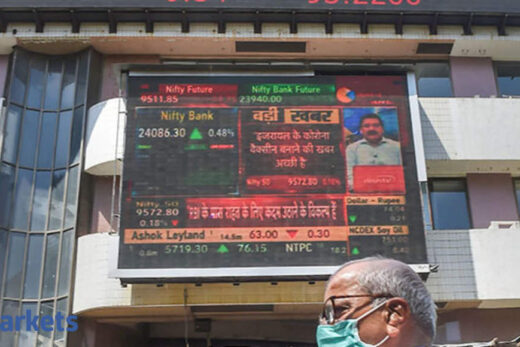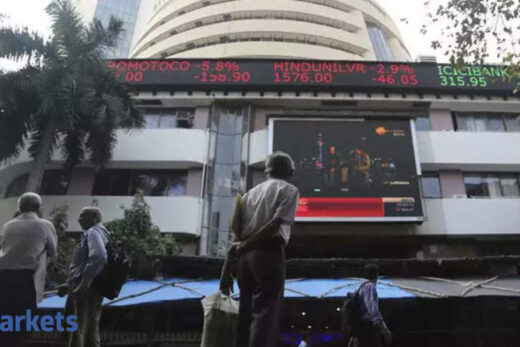.
It is easy to talk about the smallcap and midcap selloff which happened 15 days ago but the reality is that we have done rather well for ourselves this year on all counts.
It is the correct time and the Nifty 50 Index is up 20% on current year to date basis. In fact, smallcap and midcap indices have actually done better despite the correction that you have seen recently. Obviously, all the goings on have been pretty good so far in the sense that there was a lot of positive news that showed expectations are positive in the sense of strong economic recovery, Covid 2.0 receding and vaccination rates picking up.
Expectations are pretty strong on earnings growth. We are also looking at about 30 odd percent on the Nifty 50 index net profits in FY22, followed by another 14-15% in FY23. So a lot of good news so far. Most of it is priced in though. I do not know how much more incremental good news is out there. So far, the bad news is in the form of potential increase in inflation.
Bond yield interest rates have been somewhat muted and global central banks as well as RBI are taking calls that inflation is well under control even though the short-term numbers are on the higher side. They are transitory. It will come down and so there is no need to really perceive an interest rate tapering programme. As of now, a lot of good news has been priced in and I would say, incremental bad news would probably not be bad enough to drive down the market.
For the market to keep going higher or stay here, it needs fuel. Earnings are strong, liquidity is okay, what could be the next trigger?
Earnings numbers are the biggest fuel for any market. PE rerating can take you so far and the Indian market has already seen a fair amount rerating. I do not know how much more rerating can happen from where we are.
As for Nifty50, the 12 month forward PE is already at about 22 times, which is on the higher side historically. However, that may not be the correct way to look at it because the index has also changed dramatically in favour of consumer stocks, insurance names, etc where they should have much higher PE. But at least on a historical basis, the market does look on the higher side.
Bond yields being supportive on the lower side, that is what is supporting the market. If you look at individual stocks, everything has gotten pretty sharply compared to pre-Covid levels. The IT stocks example used to trade about 30×21 times on a two-year forward basis before Covid. Currently, on a two-year forward basis, most of them are trading at about 18 to 30 times.
So clearly there has been a big rerating and that is true across sectors. I would go along PE rerating from where we are, given the headwinds of reduction in bond purchase programmes by central banks including RBI by the end of the year and maybe some interest rate increases in the second half of next year both by the US Fed and the RBI.
The question is whether earnings numbers can surprise on the upside. It does not look likely. We are already building a 31% net profit growth of Nifty 50 on some of the stocks we bought earlier. This market could just remain range bound and as we roll forward over the next year and start discounting forward earning numbers, the market probably goes up. It is all about an increase in earning numbers.
As of now, short-term increases in earnings numbers have rolled out but as you roll forward, in the future, higher earnings numbers could probably drive the markets.
Are you surprised or disappointed that banks have not participated the way one would have anticipated because the first proxy to the economy is banks? Other than ICICI Bank, other banks have just done okay.
On a one year basis, they have done quite well. If you include the NBFCs, Bajaj Finance, Bajaj Finserv obviously have done very well. On a one year basis, actually banks have not done that bad. It is only over the last six months that they have underperformed the broader market but it is okay.
At this point in time, there are two-three things which are probably acting as drags on some of the banks. One is that the whole banking space will evolve over the next three to five years. The historical narrative about the banking space in India was very clear. You just bet on private banks’ market share at the expense of public banks and that is one of the ways to play that entire consumption space. In India, most people look to invest in consumption names and one way to do that was also to look at financing consumption which is what banks used to provide. So the narrative was very clear. You come to India. You look at consumption names. Banks provide a credit proxy to consumption and anyway private banks could take the market share of public banks. So it is a no brainer trade.
That has gotten muddy to some extent because one does not know how this whole banking space is going to go out. We are seeing more and more competition coming from the likes of fintech players which have disruptive models. They have already captured a fair share of market share in the transaction/payment space. There are some concerns building over there that many of these entities could actually build pretty good lending businesses starting from BNPL (Buy Now, Pay Later). That is one thing which is probably holding back some of the banks.
Second could be more company specific factors. Certain banks like HDFC Bank have suffered due to technology issues. Kotak has had regulatory related announcements with RBI. Some of these could affect larger banks also.
Right now everyone is talking about sectoral rotation. The momentum trend has seen IT doing well and continuing to do well. Same is the case with metals. Is it now time to go overweight on those segments that have seen a bit of underperformance like banks?
It depends on future data points. A lot of good news with respect to IT have already been priced in. I do not know how much more positive news is out there, especially for IT in the sense of multipliers. The current demand conditions are good but there are supply side challenges also.
I do not know whether the earning numbers can surprise positively, compared to the pretty high expectations which are already priced in currently. The same thing holds for metals also. Everybody knows about the metal cycle. Analysts forecasts are building in pretty high assumptions going forward with respect to the metal cycle. I do not know what can surprise me on the upside.
Coming to some of the sectors which have underperformed, in case of banks, we will have to wait and see but clearly the concerns around a more competitive banking environment are not going to change in a big hurry over the next six, nine months. It is not as if suddenly fintech companies will disappear. But the important thing would be whether banks themselves can demonstrate the ability narrative as they are also equipped very well on the technology side. They have access to big data. They can use all that to do a lot more incremental lending.
That is what could probably shift the narrative in favour of the incumbent banks. We will have to wait and see how much disclosures the banks come and give and how much actually happens in terms of credit growth going forward. Do keep in mind the fact that the last one-and-a-half years have been a test for any bank because the lending environment has been very subdued. But going forward, as the economy picks up, credit growth will also pick up. If the incumbent banks come back and start demonstrating pretty good, one can probably see some rerating happening for the banks which have been laggards for the last six months or so.
Valuations have been a bit of a concern. Do you think the premiums IT companies are commanding are a little too expensive or a fair valuation?
On a historical basis, everything is well above the median of trading range or even historical trading range. We have tracked the market. For the last 2 years, PE for the Nifty Index was around 15-16. Currently it is about 22 on a 12-month forward basis. So, it’s clearly well above even one standard deviation.
But at the same time, the composition of the index itself has changed dramatically over the last three, four years. Earlier, Nifty was dominated by metals and mining names, gas companies and power companies. Now many of those companies have moved out of the index and been replaced by very high PE consumer stocks or life insurance companies. So that is one point to keep in mind.
The second important point is that high valuations are also supported by low interest rate/bond yields. Look at the historical cap between earnings yields and bond yields which I track pretty closely. The time to get really worried about the market would be when the gap there is something like minus 4%. Currently we are about 160-170 bps and that may not be that big a worry.
Having said that, interest rates will start moving up. How much of that increase in bond yields can be compensated by higher earnings numbers, we will wait and see but as of now, we are looking at very high incremental growth in earnings. I would not be that perturbed by very high PE numbers. There is no point looking at PE numbers in isolation. Look at it in the context of what is happening to bond yields or cost to equity and clearly the market as well as individual stocks are getting supported by crazy low interest rates and expectations of low to modest increase in interest rates. Nobody is assuming interest rates will go up suddenly. If that were to happen, which is obviously a low probability, we could see a fairly severe correction. But that is really not our base case. We expect moderate increase in bond yields both in India as also globally.
What is your take on autos? That is the one area which has continued to underperform and valuations have been on the lower side. Do you think cost is the key pain point right now that autos will have to deal with?
I think it is a combination of both — subdued volume growth as also margin pressures. On the volume side, I am not entirely convinced that we will see a very strong recovery this time around compared to the July to February timeframe last year when we saw a very strong recovery after Covid-1.0.
My concerns are as follows; one, rural India was also impacted quite severely by Covid-2.0 whereas in Covid-1.0, rural India was absolutely fine and we saw a pretty strong demand from there supporting two- wheeler and tractor volumes last year.
Number two, urban India has had two years of significant impacts so at least lower income households have got very significantly impacted, not that many of them were consumers, but at least whatever migration we were seeing of some of these households from lower to mid income, also would have been hit to some extent. More importantly, a lot of households in the middle income group who are the typical buyers of two-wheelers and four-wheelers in India, had probably advanced a lot of purchases last year itself given concerns around using public transportation even if it was available in the first placeThat is my thesis, we will see how it plays out. I am not very clear whether we will see a big recovery in volume numbers this time around.
Secondly, there is gross margin pressure as metal and plastic prices are up significantly. The demand environment is strong enough for the auto companies to pass it on very quickly and they have been taking gradual price hikes, trying to mitigate big increases which have taken place on the raw material side, but it is not very easy to do in one shot.
Third and subsequent points would be more linked to individual sub segments of the auto sector. For example, in two-wheelers, the saturation level is already high. Almost 50% maybe already have a two-wheeler and so I do not know what is the runway of growth over here. Plus, we are seeing a very big disruption coming in the form of electric vehicles which are already fairly competitive. In EVs, two-wheelers are much more competitive compared to two-wheelers,
We are seeing fairly aggressive announcements from at least one player and that is our first electric two-wheeler company. We will have to see what it means for pricing and profitability of the incumbents. Do remember that the incumbent actually have very high returns and even the smallest player TVS has supplied 22-23% profitability.
Coming to four-wheelers, Maruti has been facing a fair amount of challenges in the compact SUV segment and this more is a long term problem and not really a short-term issue. We still do not know what is Maruti’s longer term strategy. Not that I need to worry about it now because four wheeler EVs will take some time to really become competitive. We have a lot of generic and company specific factors also which are probably holding back the auto sector currently.
What are you making of the telecom story in India? Bharti has announced a fundraiser for Rs 21,000 crore. There are also news reports that Google may be looking to invest in Bharti. Reliance Jio perhaps is going to launch low cost smartphone in association with Google. We understand that about five crore handsets is what they are going to be looking at launching with?
It looks like that is where the telecom market is headed given the financials of Vodafone Idea and no signs of any increase in ARPUs as of now. I do not know how long Vodafone Idea can really sustain its operations, given the increase in its payouts to the government going forward, both AGR and spectrum liabilities. It is not a very sustainable situation as far as VI is concerned as of now.
I assume Bharti is raising money because it sees an opportunity here. If Vodafone Idea is not able to sustain, then we will see a lot of migration of subscribers VI to Reliance and Bharti. Now, 40-50 million subscribers of Vodafone Idea cannot be absorbed that easily. They need a lot more capex to support that kind of a network. I assume that is what Bharti is preparing for.
Also, maybe it is just keeping some cash in hand given the fact that 5G spectrum auction could also be around the corner.



